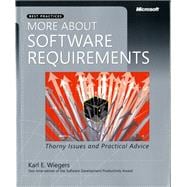
Note: Supplemental materials are not guaranteed with Rental or Used book purchases.
Purchase Benefits
What is included with this book?
Karl E. Wiegers is a leading speaker, author, and consultant on requirements engineering, project management, and process improvement. As Principal Consultant with Process Impact, he conducts training seminars for corporate and government clients worldwide. Karl has twice won the Software Development Productivity Award, which honors excellence in productivity-enhancing products and books.
| Preface | xiii | ||||
|
|||||
|
3 | (8) | |||
|
3 | (1) | |||
|
4 | (3) | |||
|
5 | (1) | |||
|
5 | (1) | |||
|
6 | (1) | |||
|
6 | (1) | |||
|
7 | (1) | |||
|
7 | (1) | |||
|
7 | (1) | |||
|
7 | (1) | |||
|
7 | (2) | |||
|
9 | (2) | |||
|
11 | (10) | |||
|
11 | (3) | |||
|
14 | (2) | |||
|
16 | (5) | |||
|
|||||
|
21 | (8) | |||
|
21 | (2) | |||
|
23 | (2) | |||
|
25 | (1) | |||
|
26 | (2) | |||
|
28 | (1) | |||
|
29 | (4) | |||
|
29 | (1) | |||
|
30 | (1) | |||
|
31 | (1) | |||
|
32 | (1) | |||
|
33 | (18) | |||
|
33 | (2) | |||
|
35 | (2) | |||
|
37 | (1) | |||
|
37 | (1) | |||
|
38 | (2) | |||
|
40 | (1) | |||
|
41 | (4) | |||
|
45 | (2) | |||
|
47 | (4) | |||
|
|||||
|
51 | (6) | |||
|
51 | (2) | |||
|
53 | (1) | |||
|
54 | (3) | |||
|
57 | (12) | |||
|
57 | (2) | |||
|
59 | (1) | |||
|
60 | (2) | |||
|
62 | (3) | |||
|
65 | (1) | |||
|
66 | (3) | |||
|
69 | (8) | |||
|
69 | (8) | |||
|
|||||
|
77 | (8) | |||
|
77 | (2) | |||
|
79 | (3) | |||
|
82 | (3) | |||
|
85 | (4) | |||
|
89 | (14) | |||
|
89 | (1) | |||
|
90 | (1) | |||
|
91 | (2) | |||
|
93 | (3) | |||
|
96 | (7) | |||
|
|||||
|
103 | (2) | |||
|
105 | (8) | |||
|
105 | (2) | |||
|
107 | (1) | |||
|
108 | (2) | |||
|
110 | (1) | |||
|
110 | (3) | |||
|
113 | (4) | |||
|
114 | (1) | |||
|
114 | (1) | |||
|
115 | (1) | |||
|
116 | (1) | |||
|
117 | (12) | |||
|
117 | (2) | |||
|
119 | (1) | |||
|
120 | (1) | |||
|
121 | (8) | |||
|
121 | (1) | |||
|
122 | (2) | |||
|
124 | (1) | |||
|
125 | (1) | |||
|
126 | (3) | |||
|
129 | (8) | |||
|
130 | (1) | |||
|
131 | (6) | |||
|
|||||
|
137 | (10) | |||
|
137 | (1) | |||
|
138 | (2) | |||
|
140 | (1) | |||
|
141 | (2) | |||
|
143 | (4) | |||
|
147 | (6) | |||
|
148 | (1) | |||
|
149 | (4) | |||
|
153 | (12) | |||
|
154 | (1) | |||
|
154 | (3) | |||
|
157 | (2) | |||
|
159 | (2) | |||
|
161 | (4) | |||
|
|||||
|
165 | (6) | |||
|
166 | (1) | |||
|
167 | (1) | |||
|
168 | (3) | |||
|
171 | (6) | |||
|
171 | (1) | |||
|
172 | (1) | |||
|
173 | (4) | |||
|
177 | (6) | |||
|
177 | (1) | |||
|
178 | (1) | |||
|
179 | (1) | |||
|
180 | (1) | |||
|
181 | (2) | |||
|
183 | (6) | |||
|
183 | (1) | |||
|
184 | (1) | |||
|
184 | (1) | |||
|
185 | (1) | |||
|
186 | (1) | |||
|
186 | (1) | |||
|
186 | (3) | |||
| References | 189 | (6) | |||
| Index | 195 |
The New copy of this book will include any supplemental materials advertised. Please check the title of the book to determine if it should include any access cards, study guides, lab manuals, CDs, etc.
The Used, Rental and eBook copies of this book are not guaranteed to include any supplemental materials. Typically, only the book itself is included. This is true even if the title states it includes any access cards, study guides, lab manuals, CDs, etc.